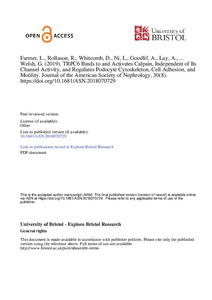Please use this identifier to cite or link to this item:
https://repositorio.uca.edu.ar/handle/123456789/8678| Título: | TRPC6 binds to and activates calpain, independent of its channel activity, and regulates podocyte cytoskeleton, cell adhesion, and motility | Autor: | Farmer, Louise K. Rollason, Ruth Whitcomb, Daniel J. Ni, Lan Goodliff, Alexander Lay, Abigail C. Birnbaumer, Lutz Heesom, Kate J. Xu, Shang-Zhong Saleem, Moin A. Welsh, Gavin I. |
Palabras clave: | NEFROLOGIA; MUTACION; GENES; TRASTORNOS GENETICOS; ENFERMEDADES RENALES; RIÑON; PROTEINAS | Fecha de publicación: | 2019 | Editorial: | American Society of Nephrology | Cita: | Farmer LK, Rollason R, Whitcomb DJ, et al. TRPC6 Binds to and Activates Calpain, Independent of Its Channel Activity, and Regulates Podocyte Cytoskeleton, Cell Adhesion, and Motility [en línea]. Journal of the American Society of Nephrology. August 2019:ASN.2018070729. doi:10.1681/ASN.2018070729 Disponible en: https://repositorio.uca.edu.ar/handle/123456789/8678 | Resumen: | Background: Mutations in transient receptor potential channel 6 (TRPC6) are associated with an inherited form of focal segmental glomerulosclerosis (FSGS). Despite widespread expression, patients with TRPC6 mutations do not present with any other pathological phenotype suggesting that this protein has a unique but yet unidentified role within the target cell for FSGS, the kidney podocyte. Methods: A stable TRPC6 knock out podocyte cell line was generated from TRPC6 knockout mice. These cells were engineered to express wild type, dominant negative or either G109S or K874* disease causing mutants of TRPC6. These cells were extensively characterised via motility, detachment and calpain activity assays, immunofluorescence and confocal or Total Internal Reflection fluorescence (TIRF) microscopy, and western blotting. Results: TRPC6-/- podocytes are less motile and more adhesive, with an altered actin cytoskeleton compared to wild type cells. Mechanistically, we show that TRPC6 binds to ERK1/2 and the actin regulatory proteins, caldesmon and calpain 1 and 2. Calpains are calcium dependent cysteine proteases, which control the podocyte cytoskeleton, cell adhesion and motility via cleavage of paxillin, focal adhesion kinase and talin. Knockdown or expression of the truncated K874*, but not the gain of function G019S or dominant negative mutant of TRPC6 results in the mislocalization of calpain 1 and 2 and significant down-regulation of calpain activity leading to altered podocyte cytoskeleton, motility and adhesion, a phenocopy of TRPC6 -/- podocytes. Conclusions: Our data demonstrates that the physical interaction between TRPC6 and calpain in the podocyte is important in disease, independent of TRPC6 channel activity. | URI: | https://repositorio.uca.edu.ar/handle/123456789/8678 | ISSN: | 1046-6673 (print) 1533-3450 (online) |
Disciplina: | MEDICINA | DOI: | 10.1681/ASN.2018070729 | Derechos: | Acceso Abierto | Fuente: | Journal of the American Society of Nephrology. August 2019:ASN.2018070729 |
| Appears in Collections: | Artículos |
Files in This Item:
| File | Description | Size | Format | |
|---|---|---|---|---|
| trpc6-binds-activates-calpain.pdf | 5,84 MB | Adobe PDF |  View/Open |
Page view(s)
248
checked on Dec 17, 2025
Download(s)
391
checked on Dec 17, 2025
Google ScholarTM
Check
Altmetric
Altmetric
This item is licensed under a Creative Commons License

